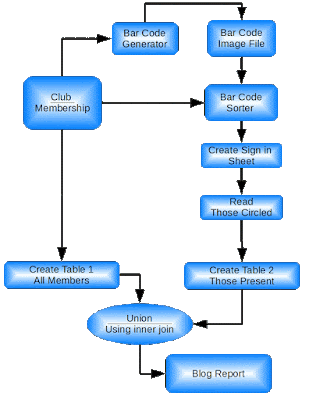Codes are everywhere. Until humans acquire the Vulcan skill of mind melding, codes are the only communication game in town. If you are reading these words you are deciphering a code. Language written and spoken is just one of many codes we come in contact with every day.
As Hams we are all familiar with Morse Code. As consumers we are familiar with bar codes. They are everywhere, including our club’s attendance sheet. It may surprise you to learn that the idea of bar codes was inspired by the Morse Code. Its inventor Norman ‘Joe’ Woodland, while vacationing on Miami Beach, had occasion to drag his fingers through the sand while pondering a better way to check groceries out of a supermarket. He noticed that some of the lines left by his fingers were fatter than others, and spaces also varied. This reminded him of the Morse Code he learned as a Bot Scout. This was in the mid fifties, however. His concept was way ahead of its time. Intense light sources like lasers had not been invented, and computers were the size of houses and hardly powerful enough to do what simple microprocessors are capable of today. Technology advanced and by 1974 the first bar code, as we know it today, was scanned at a supermarket checkout. It was on a pack of Wrigley’s chewing gum. That item was chosen to demonstrate that this technology could be placed on the smallest of packages.
The real power of the bar code comes when it is linked to a database of related information. Each product you purchase in the store has a bar code containing a unique number. That number is associated with the product’s name, its price at that store, and if it is taxable. Once the product is scanned at the checkout, it is removed from inventory, and is tallied up until it reaches the reorder set point. At that point, more product is ordered from the vendor. You can imagine how this automation saves time. Of course, it does not eliminate human intervention altogether. It is quite possible for product to leave the store without the benefit of scanning. This is caught by physical inventory, and in some cases store greeters. 🙂
Bar codes are a natural for the club attendance. Each ham has a unique identifier. It is his or her call sign. Plus, we have a well maintained and accessible database that includes various pieces of information about its members. So like the supermarkets, it is quite feasible to marry the bar code read from the attendance sheet to the club’s database to produce a report which can then be published on the blog.
As with most things, the devil is in the detail, and there are plenty of details. Fortunately, bar code generation software is readily available for free, and hand held scanners have come way down in price. Database software is also available free. From these components a system was put together. The monthly workflow follows:


